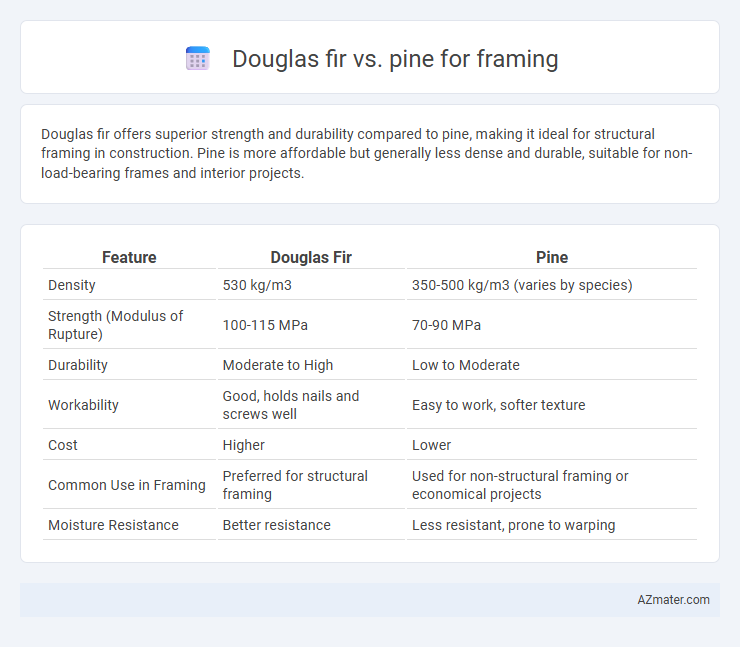Douglas fir offers superior strength and durability compared to pine, making it ideal for structural framing in construction. Pine is more affordable but generally less dense and durable, suitable for non-load-bearing frames and interior projects.
Table of Comparison
| Feature | Douglas Fir | Pine |
|---|---|---|
| Density | 530 kg/m3 | 350-500 kg/m3 (varies by species) |
| Strength (Modulus of Rupture) | 100-115 MPa | 70-90 MPa |
| Durability | Moderate to High | Low to Moderate |
| Workability | Good, holds nails and screws well | Easy to work, softer texture |
| Cost | Higher | Lower |
| Common Use in Framing | Preferred for structural framing | Used for non-structural framing or economical projects |
| Moisture Resistance | Better resistance | Less resistant, prone to warping |
Introduction: Douglas Fir vs Pine for Framing
Douglas Fir offers superior strength, stability, and resistance to warping compared to Pine, making it a preferred choice for framing in construction. Pine, while more affordable and readily available, tends to be softer and less durable, which may require additional treatment or reinforcement in structural applications. The choice between Douglas Fir and Pine depends on factors such as load-bearing requirements, budget constraints, and environmental conditions.
Wood Strength and Structural Performance
Douglas fir offers higher wood strength with a bending strength of around 12,200 psi compared to pine's approximately 8,800 psi, making it more suitable for heavy structural loads in framing. Its superior stiffness (modulus of elasticity around 1.9 million psi) ensures better resistance to bending and deflection under stress. Pine, while lighter and easier to work with, generally provides lower structural performance, making Douglas fir the preferred choice for durable and high-strength framing applications.
Durability and Longevity Comparison
Douglas fir offers superior durability and longevity compared to pine due to its dense grain structure and natural resistance to decay, making it ideal for framing in load-bearing applications. Pine, while more affordable and easier to work with, is softer, more prone to dents and insect damage, and typically requires additional treatment to enhance its lifespan. Builders prefer Douglas fir for structural integrity and long-term performance, especially in environments exposed to moisture and varying weather conditions.
Resistance to Decay and Insects
Douglas fir exhibits superior resistance to decay and insect damage compared to most pine species, making it a preferred choice for framing in environments prone to moisture and pests. Its dense grain structure and natural oils enhance durability against fungal attacks and wood-boring insects, whereas pine typically requires chemical treatment to achieve similar protection. Builders often select Douglas fir for framing projects demanding long-term structural integrity and minimal maintenance.
Workability and Ease of Handling
Douglas fir offers superior workability for framing due to its consistent grain and moderate hardness, allowing smoother cutting, nailing, and fastening compared to pine. Pine, while softer and lighter, may splinter more easily and require more care during handling, potentially increasing labor time. Both woods are widely used, but Douglas fir's durability and strength make it preferable for projects demanding robust performance and ease of manipulation.
Cost and Availability of Materials
Douglas fir is generally more expensive than pine for framing due to its superior strength and durability, making it a preferred choice for structural projects requiring high load-bearing capacity. Pine, especially varieties like Eastern White Pine and Southern Yellow Pine, is more cost-effective and widely available in most regions, making it a budget-friendly option for standard framing needs. The availability of pine often leads to faster procurement times, while Douglas fir's limited supply in some areas can increase lead times and overall project costs.
Environmental Impact and Sustainability
Douglas fir offers superior environmental benefits for framing due to its faster growth rate and higher strength-to-weight ratio, enabling less material use and longer-lasting structures. Pine, while widely available, tends to grow slower and may require more frequent replacement, increasing resource consumption over time. Sustainable forestry certifications like FSC and PEFC are critical when sourcing either species to ensure responsible harvesting and reduced ecological footprint.
Regional Preferences and Building Codes
Douglas fir is favored in the Pacific Northwest and Western Canada for framing due to its superior strength, stiffness, and resistance to warping, aligning with regional building codes that prioritize structural integrity in seismic zones. Pine, commonly used in the Southeastern United States and parts of Europe, meets local building codes emphasizing cost-efficiency and availability, though it generally requires more treatment for durability. Regional preferences hinge largely on climate, timber supply, and specific code requirements such as load-bearing capacity and moisture resistance.
Visual Appeal and Finishing Qualities
Douglas fir offers a tight, straight grain with a rich reddish-brown hue that enhances visual appeal and provides a smooth surface ideal for high-quality finishes. Pine, typically lighter with a yellowish tone and more prominent knots, tends to absorb stains unevenly, making it less desirable for fine finishing. The uniform texture of Douglas fir allows for more consistent paint and stain application, resulting in a polished, professional look in framing projects.
Final Verdict: Choosing the Best Wood for Framing
Douglas fir offers superior strength, stiffness, and durability compared to pine, making it the preferred choice for structural framing in construction projects. Pine is more affordable and widely available, yet its softer grain and lower density reduce its load-bearing capacity and resistance to warping over time. For long-term stability and heavy load-bearing frames, Douglas fir provides the best performance and value despite its higher initial cost.

Infographic: Douglas fir vs Pine for Framing
 azmater.com
azmater.com